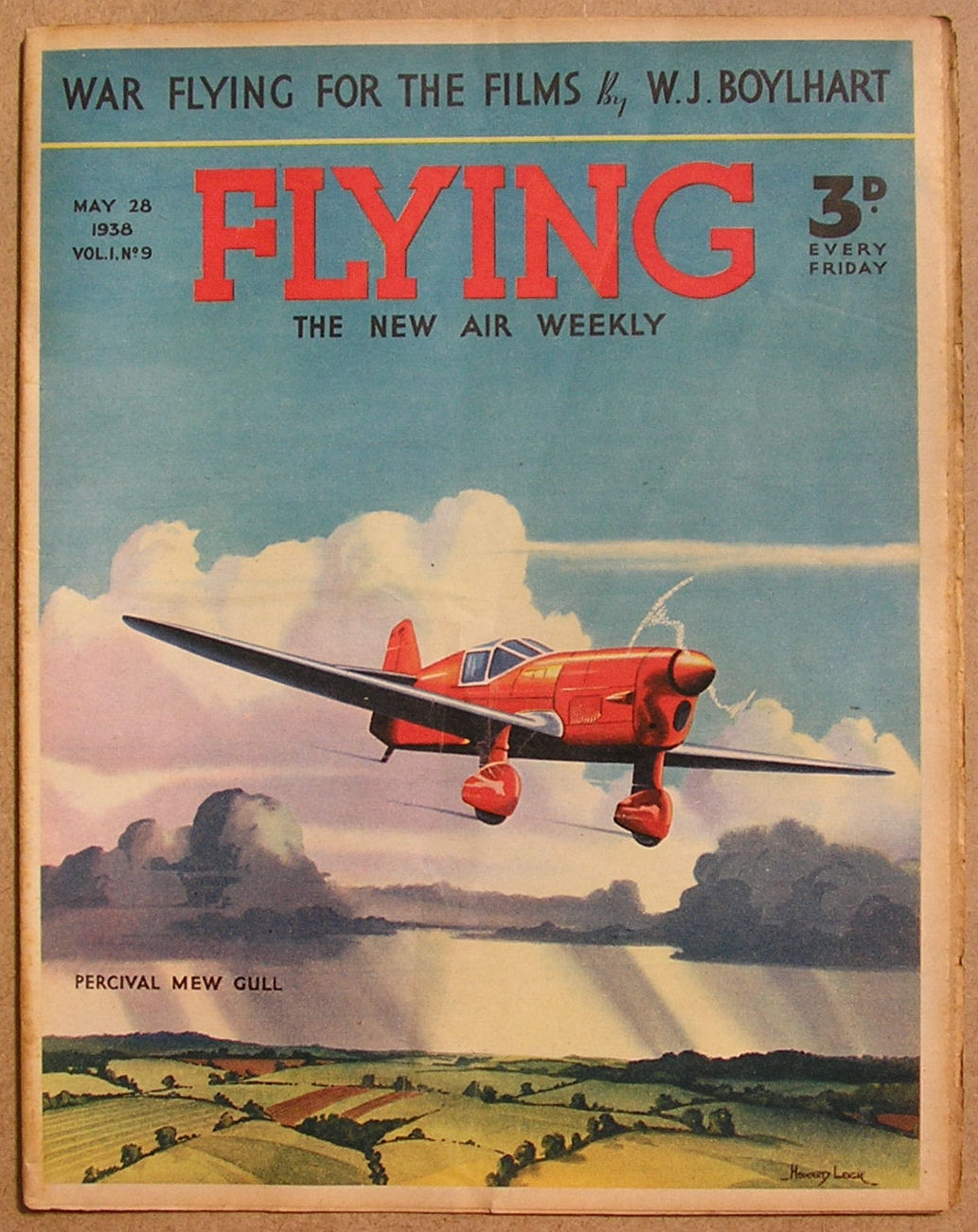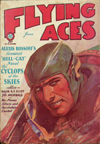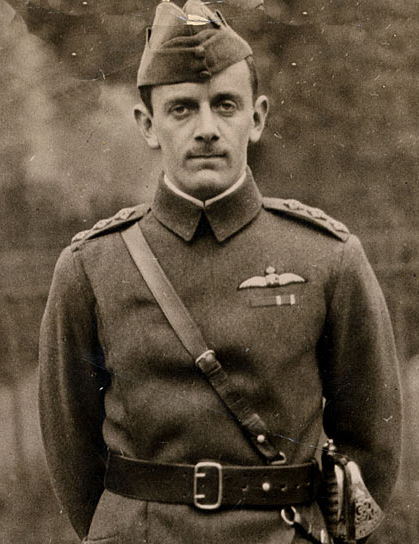Heroes of the Air: Major L.G. Hawker
WHEN Flying, the new  weekly paper of all things aviation, started up in England in 1938, amongst the articles and stories and photo features was an illustrative feature called “Heroes of the Air.” It was a full page illustration by S. Drigin of the events surrounding how the pictured Ace got their Victoria Cross along with a brief explanatory note.
weekly paper of all things aviation, started up in England in 1938, amongst the articles and stories and photo features was an illustrative feature called “Heroes of the Air.” It was a full page illustration by S. Drigin of the events surrounding how the pictured Ace got their Victoria Cross along with a brief explanatory note.
Russian born Serge Drigin became a successful illustrator in the UK in the 1920s with his work regularly appearing in such British magazines as The Detective Magazine, Modern Boy and Chums. He is probably best known for his startling covers for Scoops, Air Stories, War Stories, Fantasy and others in the 30s.
From the 28 May 1938 issue of Flying:
MAJOR L. G. HAWKER WINNING THE VICTORIA CROSS OVER THE GERMAN LINES, JULY 25, 1915
IT WAS on July 25, 1915, that Major Lanoe George Hawker was on reconnaissance over enemy territory. He was flying a Bristol Scout when he saw a German two-seater. He at once engaged it with such fury that it turned tail and fled. Continuing on his way, he encountered another two-seater. This time he was more lucky, for he sent his opponent down out of control. His third victory that day over yet another two-seater, was gained on the way home. It was almost dark at the time and the German machine must have presented a grim picture as it spun down in flames. These three successes were all the more surprising because Major Hawker, at that time a Captain, was armed only with a French cavalry carbine, while his opponents were armed with machine-guns. For his gallantry on that day he was awarded the Victoria Cross. Notification was made on the 24th of August in the London Gazette, for “ most conspicuous bravery and very great ability on the 25th July, 1915.†This fearless airman finally fell to the guns of Richthofen, but only after a long and bitter engagement which in the end was decided by the German’s superior equipment—as Richthofen himself admitted.

“Creased!” by Arnold Lorne Hicks
THIS week we present a cover by Arnold Lorne Hicks! Hicks worked in the pulps primarily from the late ’20’s to the mid 30’s, producing covers for such magazines as North-West Stories, Navy Stories, Police Stories, Detective Dragnet, Sky Birds, Golden West, Western Trails, Love Adventures, and a couple covers for Flying Aces!
Creased!
 THE deadliest wound possible to receive in the air, outside of a bullet through the heart, is the “creaser.” Many an airman has gone west in a crash as the result of a bullet wound across the head that stuns him long enough to allow the plane to get completely out of control. The same wound, received on the ground, would result in nothing more uncomfortable than a numbing headache after a surgeon had attended it. Hundreds of aviators have received serious wounds in the stomach, lungs or limbs and have been able to bring their ships down in safety, but a “creaser” leaves the pilot unconscious and unable to save himself. Captain Ball, who fell after winning the Victoria Cross, and Major Hawker, another British ace with a long list of victories, both went down to their deaths after receiving slight head wounds—wounds that, compared to their actual deaths, were mere pin scratches. Our cover this month shows us a war pilot in a similar difficulty.
THE deadliest wound possible to receive in the air, outside of a bullet through the heart, is the “creaser.” Many an airman has gone west in a crash as the result of a bullet wound across the head that stuns him long enough to allow the plane to get completely out of control. The same wound, received on the ground, would result in nothing more uncomfortable than a numbing headache after a surgeon had attended it. Hundreds of aviators have received serious wounds in the stomach, lungs or limbs and have been able to bring their ships down in safety, but a “creaser” leaves the pilot unconscious and unable to save himself. Captain Ball, who fell after winning the Victoria Cross, and Major Hawker, another British ace with a long list of victories, both went down to their deaths after receiving slight head wounds—wounds that, compared to their actual deaths, were mere pin scratches. Our cover this month shows us a war pilot in a similar difficulty.

“Creased!”
Flying Aces, June 1931 by Arnold Lorne Hicks
“How The Aces Went West: Captain Lanoe George Hawker” by C.B. Mayshark
THIS May we’re celebrating the genius that is C.B. Mayshark! Along with his cover duties for Sky Birds and Flying Aces in the mid-thirties, Mayshark also contributed some interior illustrations including a series he started in the April issue of Sky Birds that would run until the final issue that December—How The Aces Went West! It was an informative feature that spotlighted how famous Aces died. For the August 1935 issue of Sky Birds, Mayshark looks at how Captain Lanoe George Hawker “Went West!”

“How The Aces Went West: Captain Lanoe George Hawker
by C.B. Mayshark (Sky Birds, August 1935)
“Lives of the Aces in Pictures – Part 13: Major Hawker” by Eugene Frandzen
Starting in the May 1932 issue of Flying Aces and running almost 4 years, Eugene Frandzen’s “Lives of the Aces in Pictures” was a staple of the magazine. Each month Frandzen would feature a different Ace that rose to fame during the Great War. This time around we have English Ace—Major Lanoe G. Hawker!
Lanoe George Hawker joined the  Royal Flying Corps and quickly developed a reputation as an aggressive pilot. In April 1915, armed with just a few bombs and some hand gernades, he successfully attacked a Zeppelin plant at Gontrobe while flying a BE-2. This earned him the Distinguished Service Order.
Royal Flying Corps and quickly developed a reputation as an aggressive pilot. In April 1915, armed with just a few bombs and some hand gernades, he successfully attacked a Zeppelin plant at Gontrobe while flying a BE-2. This earned him the Distinguished Service Order.
A few months later, on 25th July 1915 Hawker became the first fighter pilot to win the Victoria Cross for air combat. Flying a single-seater Bristol Scout and armed with a single-shot cavalry carbine mounted on the starboard side of the fuselage, Hawker attacked an enemy two-seater over Ypres. He managed to not only bring that plane down, but two others as well—and all three had been armed with machine guns!
Promoted to the rank of major, Hawker died after taking part in one of the longest dogfights of the war. Flying an Airco DH-2 over Bapaume on 23rd November, 1916, Hawker was eventually shot down and killed by Manfred von Richthofen.

(Editor’s Note: These early installments of Frandzen’s “Lives of the Aces in Pictures” that were published in the pulp-sized issues have been reformatted from a two page spread into a one page feature.)
 weekly paper of all things aviation, started up in England in 1938, amongst the articles and stories and photo features was an illustrative feature called “Heroes of the Air.” It was a full page illustration by S. Drigin of the events surrounding how the pictured Ace got their Victoria Cross along with a brief explanatory note.
weekly paper of all things aviation, started up in England in 1938, amongst the articles and stories and photo features was an illustrative feature called “Heroes of the Air.” It was a full page illustration by S. Drigin of the events surrounding how the pictured Ace got their Victoria Cross along with a brief explanatory note. 








 Royal Flying Corps and quickly developed a reputation as an aggressive pilot. In April 1915, armed with just a few bombs and some hand gernades, he successfully attacked a Zeppelin plant at Gontrobe while flying a
Royal Flying Corps and quickly developed a reputation as an aggressive pilot. In April 1915, armed with just a few bombs and some hand gernades, he successfully attacked a Zeppelin plant at Gontrobe while flying a 